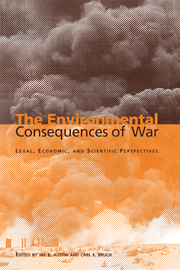Book contents
- Frontmatter
- Contents
- List of illustrations
- List of tables
- List of contributors
- Acknowledgements
- Foreword by Klaus Toepfer
- Introduction
- Part I General principles
- Part II The legal framework
- Introduction
- 2 The law of war and environmental damage
- 3 War and the environment: fault lines in the prescriptive landscape
- 4 The inadequacy of the existing legal approach to environmental protection in wartime
- 5 United States Navy development of operational-environmental doctrine
- 6 In furtherance of environmental guidelines for armed forces during peace and war
- Introduction
- 7 Peacetime environmental law as a basis of state responsibility for environmental damage caused by war
- 8 Environmental damages under the Law of the Sea Convention
- 9 The place of the environment in international tribunals
- 10 Civil liability for war-caused environmental damage: models from United States law
- Part III Assessing the impacts – scientific methods and issues
- Part IV Valuing the impacts – economic methods and issues
- Part V Prospects for the future
- Index
10 - Civil liability for war-caused environmental damage: models from United States law
Published online by Cambridge University Press: 04 August 2010
- Frontmatter
- Contents
- List of illustrations
- List of tables
- List of contributors
- Acknowledgements
- Foreword by Klaus Toepfer
- Introduction
- Part I General principles
- Part II The legal framework
- Introduction
- 2 The law of war and environmental damage
- 3 War and the environment: fault lines in the prescriptive landscape
- 4 The inadequacy of the existing legal approach to environmental protection in wartime
- 5 United States Navy development of operational-environmental doctrine
- 6 In furtherance of environmental guidelines for armed forces during peace and war
- Introduction
- 7 Peacetime environmental law as a basis of state responsibility for environmental damage caused by war
- 8 Environmental damages under the Law of the Sea Convention
- 9 The place of the environment in international tribunals
- 10 Civil liability for war-caused environmental damage: models from United States law
- Part III Assessing the impacts – scientific methods and issues
- Part IV Valuing the impacts – economic methods and issues
- Part V Prospects for the future
- Index
Summary
Introduction
This chapter explores civil liability doctrines in United States law relevant to an international liability regime for war-caused environmental damage. Those doctrines come from two separate but related fields: the common law of torts and the statutory law of environmental protection. To varying degrees they both shift the burden of environmental damage from innocent or random victims to those engaging in or benefiting from the damage-causing activity. In environmental law circles, this is often called the “polluter pays” principle. Clearly, neither set of doctrines was designed to provide compensation for war-caused environmental damages. Moreover, their use for that purpose would have to contend with countervailing doctrines of sovereign immunity and justification. Nevertheless, the principles behind the doctrines – deterrence of damage-causing conduct, provision of fairness between those damaged and those damaging, and maximization of public wealth – may be appropriate as a starting point from which to devise such an international regime. A treaty establishing an international regime could deal with the sovereign immunity and justification defenses.
While principles behind tort and pollution control legal doctrines may be relevant underpinnings for an international compensation regime for war-caused injury, this chapter concludes that another concept developed in United States environmental statutes provides the most practical alternative: a remediation fund derived from assessments on weapons, ammunition, and other war material. Such assessments could be on a sliding scale, with proportionately higher charges on weapons with the greatest potential to damage the environment. Such a mechanism would avoid much of the fact-finding inherent in most tort law, the regulatory rigidity of pollution control law, and the high transaction costs of both regimes.
- Type
- Chapter
- Information
- The Environmental Consequences of WarLegal, Economic, and Scientific Perspectives, pp. 264 - 294Publisher: Cambridge University PressPrint publication year: 2000
- 1
- Cited by



